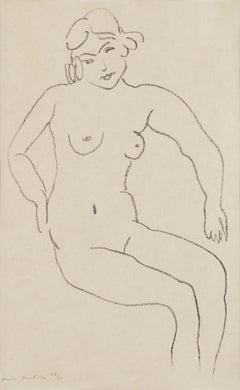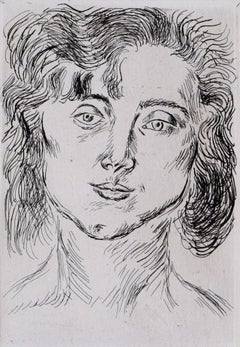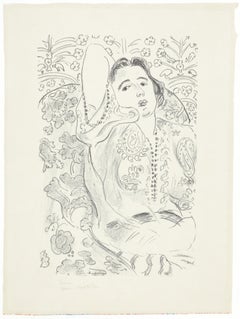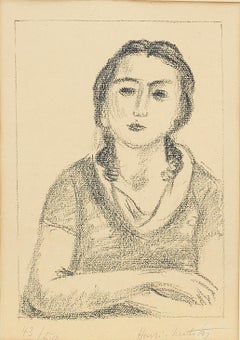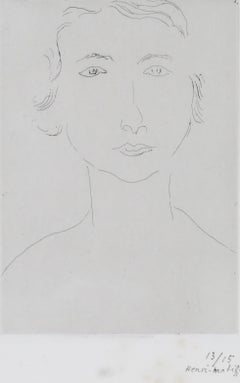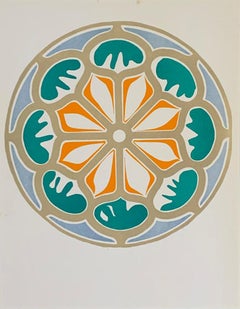Henri Matisse Prints and Multiples
Whether working as a draftsman, a sculptor, a printmaker or a painter, Henri Matisse was a master of color. Although classically trained at the Académie Julian, in Paris, he quickly abandoned traditional techniques and genres to pioneer a style all his own, marked by quick, gestural strokes and fluid contours.
Along with fellow painter André Derain, Matisse was the leading proponent of Fauvism, a movement whose name is derived from the French word for "wild beast.” Marked by vibrant hues, Fauvist paintings like Matisse’s famous 1906 composition Le Bonheur de vivre use wild, active brushstrokes and a palette unconstrained by nature, resulting in women with purple skin and trees with orange leaves. Often, these compositions unite pure color with the white of exposed canvas to create a sense of transparency and light.
In addition to masterful landscapes and still lifes, Matisse loved to paint erotic subjects, particularly the female nude. Rejecting strict realism, he distilled the form into its essential parts and then translated these into voluptuous, rounded contours. With its striking colors and sculptural modeling of the figure, Odalisque couchée aux magnolias is among Matisse’s most famous works — and the most expensive work of his ever sold — depicting Henriette Darricarrère, his muse and favorite model for around seven years, lounging luxuriously in his Nice studio. In pictures like the lithograph Nu Bleu, he explored the expressive power of a body in motion by placing his figures in twisted or contorted poses, transforming their limbs into tangles of color and shape that push figure painting toward abstraction.
Find original Henri Matisse prints, sculptures and other art on 1stDibs.
1920s Impressionist Henri Matisse Prints and Multiples
Lithograph
1950s Impressionist Henri Matisse Prints and Multiples
Etching
1920s Modern Henri Matisse Prints and Multiples
Lithograph
1920s Impressionist Henri Matisse Prints and Multiples
Lithograph
1910s Henri Matisse Prints and Multiples
Etching
1950s Modern Henri Matisse Prints and Multiples
Lithograph
1910s Fauvist Henri Matisse Prints and Multiples
Drypoint, Etching
Henri Matisse prints and multiples for sale on 1stDibs.
Artists Similar to Henri Matisse
 David Brooker Fine ArtMay 13, 2021If it's an original Matisse painting it would cost many millions of dollars. Even the simple sketches are worth hundreds of thousands and are highly collected. His pencil drawings are the most affordable of his originals and are priced in the tens of thousands to the hundreds of thousands depending on the importance of the piece.
David Brooker Fine ArtMay 13, 2021If it's an original Matisse painting it would cost many millions of dollars. Even the simple sketches are worth hundreds of thousands and are highly collected. His pencil drawings are the most affordable of his originals and are priced in the tens of thousands to the hundreds of thousands depending on the importance of the piece.- 1stDibs ExpertApril 22, 2024Henri Matisse was famous for his work as a draftsman, sculptor, printmaker and painter. He is especially well known for his use of color. Although classically trained at the Académie Julian in Paris, he quickly abandoned traditional techniques and genres to pioneer a style all his own, marked by quick gestural strokes and fluid contours. Along with fellow painter André Derain, Matisse was the leading proponent of Fauvism, a movement whose name is derived from the French word for "wild beast." Marked by vibrant hues, Fauvist paintings like Matisse's famous 1906 composition Le bonheur de vivre use wild, active brushstrokes and a palette unconstrained by nature. Shop an assortment of Henri Matisse art on 1stDibs.
- 1stDibs ExpertApril 5, 2022Henri Matisse created Icarus in 1947. It was printed using a stencil technique and was later included among 20 other pieces in his book Jazz. Shop a selection of Matisse’s pieces from some of the world’s top art dealers on 1stDibs.
- 1stDibs ExpertFebruary 27, 2024Henri Matisse stopped painting due to health concerns. In 1941, the French artist required surgery for cancer and used a wheelchair afterward. The physical limitations of his disability made it difficult for the artist to continue to produce both paintings and sculptures. However, he adapted by cutting shapes from colored paper for creative new works. On 1stDibs, find a selection of Henri Matisse art from some of the world's top dealers and galleries.
- 1stDibs ExpertFebruary 7, 2024Some of Henri Matisse's most famous paintings include Le Bonheur de Vivre, Blue Nude (Souvenir de Biskra), Woman with a Hat, Music, The Green Stripe and L'Atelier Rouge. Matisse also worked as a draftsman, printmaker and sculptor. Regardless of what medium he was working in, the French artist was a master of color. Although classically trained at the Académie Julian in Paris, he abandoned traditional techniques and genres to pioneer a style all his own, marked by quick gestural strokes and fluid contours. Find an assortment of Henri Matisse art on 1stDibs.
- 1stDibs ExpertFebruary 7, 2024Henri Matisse's art style is associated with several movements, including Postimpressionism and Fauvism. He was also the leading proponent of Fauvism, a movement with a name derived from the French word for "wild beast." Marked by vibrant hues, Fauvist paintings like Matisse's famous 1906 composition Le Bonheur de Vivre use wild, active brushstrokes and a palette unconstrained by nature, resulting in women with purple skin and trees with orange leaves. Often, these compositions unite pure color with the white of the exposed canvas to create a sense of transparency and light. Shop a variety of Henri Matisse art on 1stDibs.
- 1stDibs ExpertApril 5, 2022Henri Matisse, throughout his decades-long career, had a number of different impacts upon the art world. However, his seminal works in so-called Fauvism (French for ‘wild beast’) set him apart from the start. With strident use of color and seemingly wild brushwork, works from Matisse’s formative periods are among the most highly sought after by collectors. You’ll find a collection of expertly-vetted Matisse pieces from some of the world’s top dealers on 1stDibs.
- 1stDibs ExpertApril 5, 2022Henri Matisse's artistic style is largely classified as Fauvism. His colorful, expressive paintings also helped to influence Expressionist art. Some of the French artist's most famous paintings include Blue Nudes, La Danse and Le Bonheur de Vivre. Find a collection of Henri Matisse on 1stDibs.
- 1stDibs ExpertApril 5, 2022Henri Matisse's last painting was completed in 1951, and was titled Woman in Yellow Blouse. He also created a piece called The Swimming Pool, in 1952, which featured cutouts of divers and sea creatures in hues of blue. Shop a selection of Henri Matisse pieces from some of the world’s top art dealers on 1stDibs.
